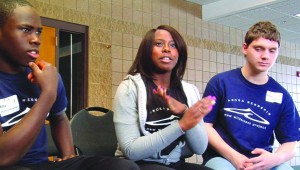In Student Voices – The New Wilderness, 100 diverse local youth discuss racism, bullying, their educational experiences
By Charles Hallman
Staff Writer
Working for the Anoka-Hennepin Public Schools, the state’s largest school district, Carolyn Lakanen saw firsthand that a safe and respectful learning environment was necessary, especially with the student population becoming more diverse. To that end, a couple of years ago she brought in New Wilderness Project, a national organization that “explores diversity and community through creative expression and adventure,” to help her produce a five-part documentary series.
“I had no clue where to begin when we first started,” admits Lakanen, who worked for the district’s student services for 22 years. Nonetheless, 100 students were selected to participate.
“You have students from Andover High School, which is known as a wealthy, White high school, verses Champlin Park High School, which is known as having much more diverse populations as far as ethnicity, race and also class [are

Photo by Sassafrass Design
concerned]. Bringing those groups together, we hoped the students would learn from each other,” notes Lakanen.
The 100 students, mostly sophomores but some juniors and seniors, were from Andover, Champlin Park, Coon Rapids, Anoka and Blaine high schools. “We wanted the representation from each school to equate to the demographics of the [respective] school itself,” says Lakanen, adding that students included those studying English as a second language, theatre and music students, and athletes. “We wanted to make sure that all the ‘ism’s were represented, so we tried to choose people from every culture in the building[s], whether it would be special ed or Goth.
“We just didn’t choose the popular kids. But we also wanted leaders within their certain groups because we know if we train these leaders, they would be listened to and respected among their peers. Every group was represented.”

Photo by Charles Hallman
During the six-hour, four-day sessions held four times during the 2010-11 school year, Lakanen says the students discussed such topics as racism and bullying. “Our goal was to have kids that were on a journey toward equity and social justice,” she points out.
“Kids talked about how they expressed racism and stereotyping [and] how they experienced bullying in ways that I didn’t realize were happening. They talked about how teachers weren’t teaching to their learning styles, and they felt their culture wasn’t being honored within the curriculum. They brought relevant, honest truth to those subjects.”
As a result, Student Voices — The New Wilderness is now available.
“When we decided to do the project, I thought if we filmed it then our teachers can hear what our kids are saying,” continues Lakanen. “If we don’t film it, only the people in the room that day would benefit. If we film it, then [both] our teachers and our students can use it as an educational tool.”
The five-DVD set includes: Personal Journey, Personal Culture, Social Dominance to Social Justice, Creative Expression, Creative Resistance, Leadership in Action, and Bridging the Gap across Difference. A discussion guide also is available with the DVDs, the producer adds.
“[It took] a year of actual filming and a year of editing. It was over a 1,000 pages of transcripts. I feel we covered everything we needed to,” says Lakanen.
More importantly, the stories were told by the students themselves, who “often are the missing voices in systemic change efforts in public schools,” believes Lakanen. “If we are looking to close the achievement gap and if we are wanting to have students engage at a higher level, then we need to listen to them.”
Many of the students told her that they gained a lot from participating in the project as well, surmises Lakanen. “That’s what our goal was, and I think that’s what we accomplished with these 100 kids. They all said…the power and sharing of stories and the empathy that grew within from people sharing their stories, and the bond the kids developed was amazing.”
Lakanen’s documentary was screened last month by educators at the National Association for Multicultural Education (NAME) conference in Oakland, California. One of the students, “Isaac,” also was there and spoke to the attendees, she noted.
Now that the project is finished, Lakanen says she is pleased with the result: “I feel the outcome was greater than anything I expected. The student voices are so compelling, so real. The process they went through was so transformative — just hearing from the students and seeing how it changed their lives.
“It was way beyond what I could have envisioned,” she concludes.
Charles Hallman welcomes reader responses to challman@spokesman-recorder.com.
To see more stories by Charles Hallman stories click HERE
Support Black local news
Help amplify Black voices by donating to the MSR. Your contribution enables critical coverage of issues affecting the community and empowers authentic storytelling.









